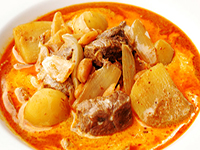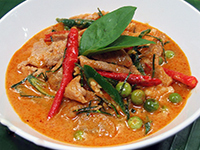Curry is a family of dishes originating in India, and the English name stems from the Tamil word kari meaning "sauce". It its most basic form, curry belongs to the same food category as goulash and chilli, in that is involves meat or seafood, cooked in a sauce with spices and herbs. The meat and spices differ, of course, but the common denominator is the use of hot spices and herbs to preserve meat in warm southern climates. Spices include coriander, cumin, turmeric, and usually fresh or dried hot chile peppers. Southern Indian curry dishes are also spiced with leaves from the curry tree.
This is very old cuisine dating back to the Indus Valley in India during prehistoric times. Oldest archaeological evidence dating to 2000-2600 BC documents the use of spices including mustard, fennel, cumin, tamarind pods, and black pepper. The oldest known Roman cookbook documents numerous recipes for meats seasoned with pepper, cumin, lovage, marjoram, mint, cloves and coriander.
"Curry powder", a prepared mixture of spices, is a Western creation dating to the 18th century. It is a spice mixture developed by the British to approximate the taste of Indian cuisine at home. There is no standard formula for curry powders sold in Europe and North America, but most are composed largely of ground turmeric, yielding a very yellow sauce. Other lesser ingredients include coriander, cumin, fenugreek, mustard, chile, black pepper and salt. In contrast, curry seasonings and pastes used in India are extremely diverse: red, yellow, brown; some with more than 20 spices. In addition to the ones mentioned above, other common spices used in India are allspice, white pepper, ground ginger, cinnamon, roasted cumin, cloves, nutmeg, mace, green cardamom seeds or black cardamom pods, and bay leaves. However, for practical reasons, curry powder packages from your local store are just fine if the individual Indian ingredients are difficult to find.
"Curry" is also a word invented in the West; one would not find a Curry section on the menu in a restaurant in New Delhi (unless it is a tourist trap). Instead, there would be dishes such as Murg Sirka Pyaz (a succulent chicken tikka in tomato sauce). There may be dishes using the work "curry" but these are names back-adopted from English. Indians generally do not use the term "curry" unless they speak english.
Since the 17th century, the vast British empire served as a vehicle to spread Indian cuisine to England and other corners of the empire. This is how "curry" made its way to South Africa and West Indies (Jamaica, Trinidad and Tobago, Guyana and the Bahamas. In English cuisine, curry is made most often made with chicken or lamb, but in the cuisine of the West Indies all kinds of things are curried: chicken, duck, goat, fish and shrimp.
The 1758 edition of Hannah Glasse's "The Art of Cookery" contains a recipe "To make a currey the Indian way". Curry was first served in British coffee houses starting in 1809. During the British Raj, the rule of the British Crown in the Indian subcontinent between 1858 and 1947. Curry grew increasingly popular in Britain owing to the large number of British civil servants and military personnel being based in India. Following World War II, curry popularity in Britain continued to grow, owing to the large number of immigrants from South Asia. By the 1990s, curry became so much integrated to the British cuisine that dishes like Chicken Tikka Masala are now referred to as a "true British national dish", reflecting the multi-cultural nature of modern-day Britain.
English pubs have adopted a number of Indian names to identify popular dishes, but the recipes do not. Examples are dishes like "Madras Curry" (the standard hot, slightly sour pub curry), Phaal (generally the hottest pub curry, although there is nothing like it in India), Roghan Josh (a medium-spicy curry, usually made with lamb, with a deep red tomato and paprika sauce, deriving from a Kashmiri dish of the same name), and Vindaloo Curry (generally regarded as the classic hot pub curry). Such transformations are common in the world of culinary fusion. The world knows "goulash" under its Austrian/Czech version (thick sauce with dumpligs), rather than it its original Hunarian version (soup in a kettle).
At the end of WWII, there was a dish invented in war-torn Berlin called the Currywurst. It is no accident that it happened in Berlin, because it reflects the postwar cosmopolitan realignment of modern-day Germany. Ketchup came from the American soldiers, curry powder from the British soldiers, topping a German Knackwurst. Currywurst is typically sold at diners or fast-food stands called "Imbiss" and served with French fries.
Curries share a common ground with goulashes and chillies, in that they all involve meat cooked in a sauce seasoned with various mixtures of spices and herbs. The chile peppers obviously differ from Hungary to Texas to India, but they are all from the species Capsicum annuum or Capsicum frutescens. The cultivars of Capsicum annuum are the most widely spread and include everything from the Hungarian Wax Paprika, to the NuMex chiles cultivated in New Mexico, to the Jalapeño, the Habanero, the Indian Jwala (Hot Finger Chile), Dhani (Bird Chile, African Devil).
Curries share one more thing with chillies and goulashes. Just like the British empire served as a vehicle to spread spicy Indian curry sauces around the world, the Austrian empire served as a vehicle to spread the goulash around the world, and the export and global dominance of American popular culture helped spread the original Chile Con Carne from Texas to the whole world.
But curry did not only spread westward to Europe and to the Americas. It was proliferating also throughout Southeast Asia. As it did so, its character changed the farther from India it was. In Myanmar (Burma), the closest to India, Burmese cuisine is based on a different understanding of curries: the principal ingredients of almost all Burmese curries are fresh onion, Indian spices and red chile peppers. Meat and fish are the main ingredients. Burmese curries come in two types: hot spicy dishes exhibiting north Indian influence, and the milder sweet curries that are similar to Thai curries. Burmese curries almost overwhelmingly lack coconut milk, setting them apart from most Southeast Asian curries.
In Thailand, curries are called Kaeng and have a soup-like consistency. They usually consist of meat, fish and vegetables in a sauce made from a paste made from chiles, onions or shallots, garlic, shrimp paste, and local ingredients such as chili peppers, kaffir lime leaves, lemon grass, galangal. Curry from central and southern Thailand has lots of coconut milk, while northern Thai curries generally do not contain coconut milk, similar to Burmese curries. Owing to the use of sugar and coconut milk, Thai curries are sweeter than Indian curries. Thai red curries use red chiles, green curries use green chiles. Yellow curry is more similar to Indian curries, with the use of turmeric, cumin, and other dried spices.
 |
Massaman Curry |
"Massaman Curry" is a Thai recipe that translates as "Muslim Curry". The principal seasonings include turmeric, cinnamon, cumin, cloves and nutmeg. These are Middle Eastern and Indian in origin, and were introduced into Thailand by Muslim, and later Portuguese, traders. Thai cuisine gives this imported dish a soup-like consistency, which is sets it apart from traditional Indian curries.
The dish has a wonderfully fragrant nutty flavor. It usually contains coconut milk, roasted peanuts, potatoes, bay leaves, cardamom pods, cinnamon, palm sugar, fish sauce, and tamarind sauce. Massaman Curry is most commonly made with beef, but can also be made with duck, chicken, or tofu. It is served with rice and sometimes with pickled ginger sauce made with cucumber and peppers macerated in vinegar.
Ingredients:
- 2 tablespoons sugar
- 1/2 tablespoon salt
- 1 cup potato
- 1 tablespoon masaman curry paste
- 1/2 cup coconut milk
- 1/2 lb beef
- 1 tablespoon tamarind Optional
- 1 cinnamon stick Optional
- 1/4 cup cashew
- 2 pinches cardamom
- 2 leaves bay leaf
Preparation:
- Peel and cut up potatoes into big chunks, 1" x 1" x 1". Cut up beef and onion into the same size.
- Heat coconut milk and masaman curry paste in a pot over medium to low heat and stir. Break up the paste and mix well with coconut milk. Stir constantly to keep the mixture from sticking. When you see the red oil bubbling up (about 5 minutes), add the meat and stir to cover the meat with curry. Add half a cup of water or enough cover all the meat. Add the rest of the ingredients, except for potatoes, onion and cashew. Stew for 1/2 hour or until beef is getting tender. Add potatoes, onion and cashews. Let simmer for 20 minutes more. The liquid should be reduced and you should be able to see some chunks. But, if the liquid is very low, add more water.
- Serve hot with cold cucumber-in-vinegar salad.
 |
Panang Curry |
Panang curry takes it name from the state in Peninsular Malaysia by the Strait of Malacca. Panang curry is similar to Massaman Curry, but has a richer, sweeter and creamier texture. Like in Massaman Curry, peanuts are also found in this recipe, and are a key ingredient.
At The Robin Hood pub in Bangkok, they make Panang Curry with shrimp or chicken, but beef is otherwise the most famous type.
Ingredients:
- 3/4 lb medium shrimp, peeled and de-veined
- 3 tbsp homemade Panang curry paste or prepared curry paste
- 2 cups coconut milk
- 6 kaffir lime leaves, torn
- 1/4 cup ground roasted peanuts
- 1/4 tsp salt
- 3 tbsp palm sugar
- 2 1/2 tbsp fish sauce
- Slices of fresh red chili for garnish
Preparation:
- Heat 1 cup of coconut milk over medium heat until the oil surfaces. Add curry paste, stir constantly for 2 minutes until fragrant and red oil surfaces. Add the beef, and cook for a further 5 minutes or until done. Add the remaining coconut milk.
- Season to taste with salt, fish sauce and sugar. Add roasted peanuts and kaffir lime leaves. Stir well to combine.
- Transfer to a serving dish, garnish with red chilies. Serve hot.
back to Radim and Lisa's Well-Travelled Cookbook | email us
Last updated: October 5, 2016
Some photographs from Wikimedia Commons are used under the terms of the GNU Free Documentation License.